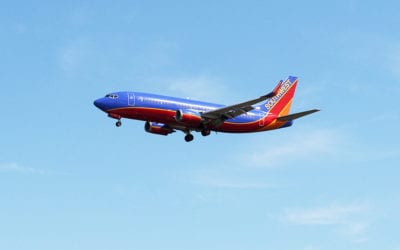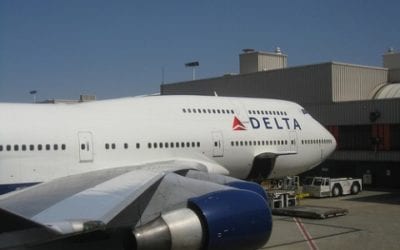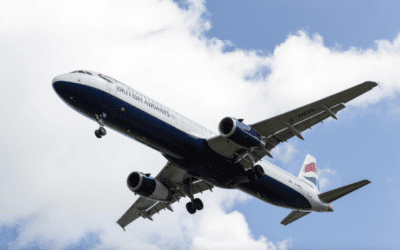
Now that the volcanic dust has settled (for the moment), what will the fallout be for European travel in the short, medium, and long term?
The disruption of air travel caused by a volcanic eruption in Iceland earlier this month (and concerns that the cloud of fine, hard, abrasive volcanic dust could cause turbine bearings and blades to fail) was news worldwide. In Europe, where I was traveling (and wondering both how crowded my trains would be within Europe, and whether and when I would get home), the news was all volcano and air travel crisis, all the time, for the better part of a week.
Readers in the U.S.A., however, may not have realized quite how serious the crisis was, how many people were affected, or — most importantly — how much impact it may have had, as the events of the 11 September 2001 had on travel in the USA, on European attitudes toward air travel in general.
Some people I know, even some Europeans, think I’m wrong. The public has a short memory and a large desire for cheap flights, they argue. Unless there’s another large eruption soon, they think Europeans will go back to air travel as usual.
Maybe, but I’m not convinced, not least because further eruptions from the same volcano are highly likely. The last time this volcano erupted, as the newsreaders kept reminding us, it did so on and off for several years. And it’s in pretty much the worst possible location for both transatlantic and European air travel, on the great circle route between North America and Europe and directly upwind from the busiest European airspace and some of the world’s largest air transit hubs.
I also think that, as in the U.S.A. after September 11, there has been real trauma and a permanent (or at least lasting) shift in attitudes among Europeans who had taken the reliability and availability of air travel for granted, getting on a plane for a city-break weekend, business meeting, or football match with only the clothes on their back and hardly any cash in their wallet.
If European air travel is forever after divided into “before Eyjafjallajokull” and “after Eyjafjallajokull”, what might that mean? Specifically, what are the implications of the volcanic ash aviation crisis for my plans to travel to Europe next week, this summer, or next year?
Because I was already planning to attend April’s monthly Strasbourg session of the European Parliament after my testimony earlier in Brussels (and had reserved my train tickets from Berlin before I left the USA), I was the only travel journalist in the press gallery of the Hémicycle for the extraordinary three hour plenary discussion on air transport policy that preempted Parliament’s planned agenda on Tuesday, April 20th, in the midst of a crisis which at that point had no end in sight.
Some MEPs (Members of the the European Parliament) and staff members were absent, unable to return from outside Europe or unable even to reach Strasbourg from the periphery of the expanded EU. Others had traveled for two days or more by car, bus, or slow train, and continued to trickle into Strasbourg throughout the remainder of the week. Despite some grumbling, even some anger on the floor (attenuated by the need for 23-way simultaneous translation) from those who had made special efforts to be in attendance, all voting was postponed until the next part-session in two weeks in Brussels, to avoid disenfranchising those whose representatives were unable to be present.
Nobody had really expected such an eruption, even if in some sense responsible authorities “should” have. It’s rather like an earthquake in California: we all know that’s highly likely some time, but few of us are really prepared for it at any moment. Despite a certain amount of partisan posing, there was considerably less finger-pointing and attempting to assign blame than I had expected. My impression was of a chamber looking forward, not back, and seriously engaged with trying to figure out what ought to be done so that this wouldn’t happen again.
The costs exceeded a billion Euros to airlines alone, and many times that to individuals and other businesses. More flights were canceled, for a longer period of time, and more passengers were stranded with fewer alternative ways of getting home, than in North America after September 11, 2001. Businesses even outside the travel industry were affected, not just because of stranded employees but because goods, supplies, components, and materials normally delivered by air freight weren’t available. In the wake of this crisis, the risk of just-in-time inventory or supply-chain management that depends on air shipping is being reevaluated by companies around the world. (Just one of the business school case studies likely to come out of this episode!)
Nobody wants to cut corners on safety or used the word “overreaction”, but there’s extreme financial pressure to learn from the additional data about volcanic ash effects on jet engines provided by this eruption, and to find ways keep more airspace open during future eruptions.
In the short term, Eurocontrol is already implementing a more graduated and granular system of air space closures, under which only smaller areas with higher ash densities will be closed to civil aviation. It’s possible — indeed, quite likely — that there will be more ash eruptions from Eyjafjallajokull, sooner or later. But under this new regime of air traffic control, they are likely to affect fewer flights for shorter periods of time, and primarily in the far north of Europe (northern Scandinavia, the Baltic countries, Scotland, Ireland) rather than the main Western European air hubs in London, Paris, Amsterdam, and Frankfurt. And unless all major European airports are shut down at the same time, diverted flights won’t end up so far away from their intended destinations as happened this time around, and the backlog of stranded passengers won’t become weeks long.
This eruption is, however, a reminder that any flight is always subject to delay or cancellation. Week-long closures of European airspace are unlikely to be repeated, but you should never plan to arrive the same day as an essential meeting or event, the departure of a tour, or the sailing of a cruise ship. Especially with a long-haul flight, plan to arrive a day or two in advance, and plan to get home a day or two before you absolutely have to be back at work.
With that caveat, I’d have no hesitation getting on a flight back to Europe tomorrow, with reasonable confidence that the extent of the disruption earlier this month is very unlikely to be repeated.
In the medium term, should you travel to Europe this summer? I had been considering, but hadn’t committed to, such a trip myself with my partner, and I’m on the fence.
I wouldn’t cancel plans that I’d already made (although I might rebook flights to arrive a couple of days before any tour or cruise, and to get back a couple of days before I had to be back at work). In most respects I expect that it will be travel as usual in Europe this summer.
But how much will it cost, if you haven’t already locked in the price by buying airline tickets and a package tour or cruise?
In a normal year, available prices for transatlantic summer air travel would increase steadily between now and the summer, not because fares would increase (barring unpredicted fluctuations in demand, summer fares have already been set) but because the seats allocated to the cheaper fares will fill up, leaving only higher-fare seats available.
As a result, even a substantial reduction in late bookings for summer transatlantic travel is likely to mean only that current airline ticket prices remain available closer to, or even into, the summer, rather than that airlines actually have to reduce their prices. So if you are still planning to travel to Europe this summer, buy your tickets sooner rather than later get the best prices.
Keep in mind that, because the population of Europe is substantially greater than that of North America (there are now more than 500 million people in the E.U. alone, and more in the rest of Europe), and because international and transatlantic travel is much more common for Europeans than for North Americans (it’s much higher for Canadians than for people in the USA, but there aren’t enough Canadians to have much effect on the North American average), the majority of passengers on transatlantic flights are Europeans traveling to and from America, not Americans traveling to and from Europe. So total demand for transatlantic seats will be affected less by whether Americans are afraid to get stuck in Europe at the end of their summer vacation than by whether Europeans are afraid to get stuck in America at the end of theirs, if there’s another volcano-induced air travel crisis.
The larger factor, and the more difficult one to predict, is the extent to which, if Europeans who normally take their vacations overseas stay home for fear of flight cancellations, and spend their summer traveling in Europe, that increased demand from intra-European travelers will drive up high season prices of European accommodations. That’s likely to be particularly problematic for North American visitors, as I pointed out in an interview in USA Today, since comparable hotels in most European cities are already substantially more expensive than comparable hotels in comparable North American cities.
A major shift from air travel to train travel within Europe, if it happens, could also make it more important than usual to make intra-European train reservations (and, if you aren’t using a prepaid Eurailpass, to buy your tickets), further in advance, especially for fast through long-distance trains and perhaps most of all for sleeping berths on overnight trains. Most European railroads now have “capacity controlled” discounted advance purchase fares like those of the airlines, and once the cheap seats are sold the walk-up rail fare can go up by a factor of five (as with airfare). I expect that foreign tourists with rail passes (especially those with first-class passes), will still be able to get where you want without difficulty. But you may have to take a slower, less comfortable train that stops more often, rather than the TGV or its counterparts, and you may have to spend the night sitting up in a chair car, or break up your journey into shorter legs, to cross the European continent.
For years, EU members have been squabbling over national governments’ subsidies to their respective national airlines. In this crisis, though, there’s a recognition that airlines shouldn’t have to bear the entire burden of paying for accommodations and meals for delayed passengers, as is required by current EU regulations — even when the delay is no fault of the airlines — for EU airlines for all their flights (and for foreign airlines, but in their case only for delayed flights departing from the EU). Regardless of whether the airline consumer protection regulations are amended, there is likely to be a one-time exception to the anti-subsidy rules to permit EU governments to make loans or offer other crisis assistance to distressed airlines.
That may not be enough, though, especially for short-haul low-fare airlines. It’s one thing for British Airways to have to absorb the cost of a hotel night or two in London for the holder of a $1000 intercontinental ticket, and another for RyanAir to have to do the same for the holder of a 20 pound (US$30) ticket from Luton to someplace just across the English Channel. And some of the financially weakest airlines in the aftermath of the ash crisis may be those based in countries whose governments are in their own financial difficulties. I wouldn’t be surprised to see some low-fare short-haul intra-European airlines go out of business, if not this summer when their flights are full than during next winter’s low season air travel doldrums.
In the long term, visitors and Europeans alike may see some much more positive changes.
The dominant themes I heard in the European Parliament discussion were of recognition (with an undercurrent of surprise from Conservatives and MEPs from the “New Europe”, and a certain amount of “We told you so” from the Greens and to a lesser extent the Left), that:
- Fast and comfortable and seductive as it is, air travel isn’t as reliable as people had come to think, and as a system doesn’t “fail gracefully” when it does fail; and
- Long-distance and especially transcontinental European surface travel doesn’t work well by any mode, and has problems that have been overlooked or neglected.
Cars are convenient for short distances, but Europeans are unused to road trips over the sorts of distances than Americans commonly travel by car. Facilities and services along European highways, except those for truck drivers, are largely oriented toward the needs of short and medium distance travelers. And while the EU and its newer members have placed a high priority on road construction, the network of new highways is still thin and limited in capacity.
With very few exceptions, central European rail systems have received neither the investment that has gone into roads in the enlarged EU, nor that which has gone into high-speed rail in the wealthier western European countries. Instead, both the nouveau riche and the “guest workers” traveling between jobs in the West and family in the East have switched to the new wave of low-cost central European short-haul airlines such as Wizz Air.
While passenger rail networks across Europe are dense, they aren’t well integrated. As was and often still is the case in the USA, transcontinental journeys often require separate reservations and tickets on different airlines, and sometimes awkward transfers between multiple stations in transit cities. And through schedules, much less through reservations or tickets, are often difficult to obtain. All of this is especially true for travel in whole or in part in the eastern portion of the enlarged EU, or beyond.
The ash cloud crisis brought all of this into sharp focus. On the floor of the plenary, MEPs told horror stories of difficulties in arranging train reservations and tickets back to Strasbourg from the enlarged European periphery, traffic-choked highways, and two-day journeys on trains with overflowing toilets and people sleeping crowded together in the corridors.
And, this being Europe and not the USA, there was a recognition across the spectrum that this was a result of misguided government priorities and failed government planning, to be rectified not through further deregulation but by reform of EU-level transportation policy.
It’s hard to tell exactly what that might mean, but some likely elements of such a policy would be:
- A significant shift in EU transportation infrastructure funding priorities, especially in the new EU members, from road and air to rail transportation, and especially to upgrading of main intercity passenger lines and integration of central Europe into the Western European high-speed rail network. I strongly suspect that this eruption will come to be seen as having been the key turning point in central European intercity passenger rail policy.
- Removal of key bottlenecks and closing of key gaps in the transcontinental European mainline rail network. The most obvious of these would be the reopening of the Somport rail tunnel through Canfranc (see the details and links in my earlier article here), formerly the main line through the Pyrénées between the Iberian Peninsula and the rest of Europe, closed since 1970 (!) not because of any problem with the tunnel itself but due to a petty argument over the cost of repairs to the approaches. Iberian airports remained open throughout most of the ash crisis, and many flights were diverted to Madrid. But with the line through Canfranc closed, the limiting factor was capacity on the slower, less direct coastal rail routes around the Pyrénées. A consortium of tour operators had to charter a cruise ship from Bilbao to Southampton to get a couple of thousand diverted British tourists home from Spain to England. This crisis could be what it takes for rail planners and politicians in Spain, France, and throughout the EU to recognize the strategic imperative to repair the approaches and re-open the Sompoort tunnel as part of a high-speed Iberian rail link. Some signs of that possibility are already visible.
- A much higher priority on international and pan-European integration of passenger rail reservations and ticketing systems to facilitate through transcontinental bookings. These are primarily IT issues that can be addressed much more quickly than new track can be laid, and could have major benefits for foreign visitors within as little as a year or two.
- Greater skepticism about the reliability of air travel that will make both politicians and the public more receptive to a variety of environmental arguments (and more likely to question bogus rebuttals from airlines) such as those against funding and land-use permits for airport expansion and upgrading and those for climate-change taxes or caps on aviation emissions or their inclusion in emissions-trading schemes.



